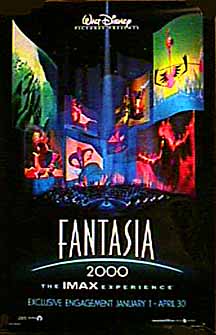Fantasia/2000
Released Jan. 1, 2000 by Walt Disney Pictures in IMAX 15/70 format on Kodak Vision color film, 6-channel digital sound, 90 mins.
Production:
- Produced by Donald W. Ernst and Roy E. Disney (executive producer) Ê
- Directed by James Algar (The Sorceror's Apprentice), Gaetan Brizzi and Paul Brizzi (Firebird Suite), Hendel Butoy (Pines of Rome, Steadfast Tin Soldier), Francis Glebas (Pomp and Circumstance, Marches #1, 2, 3 and 4), Eric Goldberg (Rhapsody in Blue, Carnival of the Animals), Pixote Hunt (Beethoven's Symphony No. 5, Allegro con Brio)
- Music by Paul Dukas (The Sorceror's Apprentice), Edward Elgar (Pomp and Circumstance March No. 1), George Gershwin (Rhapsody in Blue), Ottorino Respighi (Pines of Rome), Camille Saint-Sa‘ns (The Carnival of the Animals), Dmitri Shostakovich (Piano Concerto No. 2), Igor Stravinsky (The Firebird), Ludwig van Beethoven (Symphony No. 5)
- Music Production by Chicago Symphony Orchestra conducted by James Levine, Peter Gelb (executive producer), Jay Saks (audio producer)
- Film Editing by Jessica Ambinder-Rojas , Lois Freeman-Fox, Julia Gray, Craig Paulsen, Gregory F. Plotts
- Art Direction by Dan Cooper, Susan Goldberg, Dean Gordon, Michael Humphries, Carl Jones Ê
- Sound by Gregory King, Robert L. Sephton
Notes:
"One of the key elements in making Fantasia/2000 a reality was the involvement of a major musical talent as an active collaborator. Renowned maestro Leopold Stokowski had joined forces with Walt Disney to help create the 1940 classic. For this latest project, the filmmakers turned to acclaimed conductor James Levine, whose 28-year association with the Metropolitan Opera has earned him a special place in the musical world. Among the many highlights of Levine's career is his 20-year stint as music director of the Ravinia Festival, where he led The Chicago Symphony Orchestra. Based on that longtime connection, that orchestra was selected to record the new musical selections for Fantasia/2000. Five sessions took place over several years at Chicago's historic Medinah Temple, where state-of-the-art digital recordings were made to capture the acoustics of an authentic concert hall. As many as 110 musicians took part in each of those sessions. Peter Gelb served as executive music pro- ducer/music consultant. Jay Saks was the audio producer. Levine, who had been influenced by the 1940 Fantasia as a young boy, was eager to be a part of this latest Disney project. "I could hardly wait to say yes," he recalls. "I was so thrilled that they thought of me and asked me to do it. It's been great fun to watch the animation come to life because, of course, I had to understand the animation concept before we recorded the music. I was happy that they trusted what I was doing and it was very easy to trust what they were doing. I could see right away what a very large group of incredibly talented people this work takes." "James had very strong feelings about the integrity of the music and made that the first of the building blocks," notes Roy. "He was well aware of what our stories were going to be but he had a tremendous belief that if he did the music right, we not only could but would be able to animate to it." Selecting the musical program for Fantasia/2000 required a great deal of thought and consideration. Roy observes, "It had to be descriptive music. It had to be something that had the sense of a story progression, somehow or another, and it had to be just appealing to us as music. We had a lot of fun picking the music." In making their choices for the musical program, the filmmakers listened to hundreds of pieces of music, including many that were suggested for the 1940 production. Like its pioneering predecessor, this new version of Fantasia embraces all the latest technological tools and innovations to tell its stories and create breathtaking imagery. Each of the new segments uses a style or combination of approaches that is right for that particular story. For example, the animated whale characters in Pines of Romewere created with the help of cutting-edge software packages for computer-generated imagery. The ballerina in "The Steadfast Tin Soldier" (set to the music of Shostakovich's Piano Concerto No. 2) required the design of a new computer program that would allow the hair and costume to move in response to the animators' hand-drawn efforts. A special particle system was implemented for the first time in the Firebirdsequence to allow some spectacular movement and effects. Those sequences are in contrast to the Rhapsody in Blue number, which is an elemental kind of animation using stylized drawings on a flat plane; the rich classic 1940s' style animation of Donald Duck in Pomp and Circumstance; and the "painterly" look and traditional styling of Beethoven's Symphony No. 5. Fantasia made motion picture history in 1940 when it became the first film to be recorded and released in stereophonic sound. The process was called Fantasound and the film traveled from city to city in special roadshow engagements. For the New York premiere, 36 speakers were installed behind the screen, with 54 others placed throughout the orchestra and balcony at a cost of $85,000. The release of Fantasia/2000 is similarly making motion picture history. When it debuts on January 1, 2000, exclusively at IMAX theatres around the world, it will be the first theatrical feature-length film ever released in this giant-screen, large-format process. Fantasia/2000 will have its world premiere at Carnegie Hall on December 17, 1999, when the film will be shown with live accompaniment by the 120-piece Philharmonic Orchestra of London. Similar live performances will follow in London, Paris and Tokyo before a spectacular Fantasia/2000 Millennium Eve Gala unfolds at the Pasadena Civic Auditorium on December 31." (quote from the Fantasia/2000 Educational Resource Guide:Music)
Links:
History Department | Filmnotes | revised 1/3/2000 by Schoenherr

